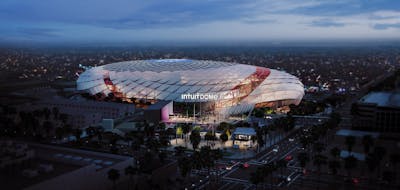
Dickies Arena
Designing for versatility
Project Facts
| Location | Fort Worth, Texas |
| Owner | City of Fort Worth |
| Size | 717,200 SF |
| Cost | $450 million |
| Status | Completed 2019 |
| Capacity | 14,000 seats |
| Certifications | LEED Silver |
Overview
In 2014, the citizens of Fort Worth, Texas voted to approve the construction of a new venue—one capable of hosting nearly any kind of event while expanding the cultural district and complimenting the historic Will Rogers Coliseum. The 715,000 square foot Dickies Arena realized this vision. The new 14,000-seat multi-purpose arena is now an icon in the Fort Worth area, hosting major events such as the Fort Worth Stock Show & Rodeo, NCAA Men’s Basketball tournament, hockey games, festivals and more. Walter P Moore’s efficient, constructible solutions brought the architects’ vision to life, creating a world-class facility that boasts some of the best amenities in the country.
Services
About the Project
As the most prominent feature of the arena, the 280-foot by 420-foot clear span roof presented a substantial structural engineering challenge. It was crucial that the roof function efficiently while maintaining exceptional acoustics to enhance the audience’s enjoyment of various performances. To address this challenge, our team devised an innovative solution—a vaulted, oval-shaped dome with a specialized roof deck. This deck possesses outstanding acoustical properties, eliminating the need for additional acoustic panels.
Supported by a perimeter tension ring at the base and a smaller compression ring at the apex, the roof structure incorporates 2,000 kips of post-tensioning on the concrete lower roof level to offset tension ring loads, resulting in a column-free space beneath. Our custom digital workflows enabled us to assess hundreds of thousands of potential rigging configurations, ensuring the rigging grid’s capacity and flexibility met the demands of diverse events.
Construction Engineering
Given the vast size—nearly three football fields—the roof had to be assembled by raising individual sections, necessitating temporary supports until completion. The dome’s curved trusses functioned as beams during construction, requiring a unique load analysis for each member and connection in the temporary state. Our Construction Engineering team meticulously analyzed the structure and devised a comprehensive erection sequence to maintain structural stability throughout construction. We also undertook the design of shoring towers, custom header systems, and tower foundations, ensuring efficient, constructible solutions that brought the architects’ vision to life.
The architects aimed to create a distinct, intimate atmosphere unparalleled by other rodeo venues. In the seating bowl, we were tasked with reducing the floor-to-floor height to enhance intimacy and sightlines for fans. Our solution involved an unconventional framing layout that upturned major beams, which were seamlessly integrated into the suite elements to act as natural dividers. This innovative structural approach maximized available space, contributing significantly to the arena’s overall intimacy. Additionally, we strategically incorporated the north and south clubs within the bowl, allowing patrons to access premium amenities without leaving the event, further enhancing the overall fan experience.










